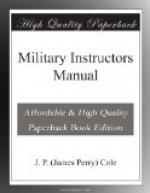Refrain from employing any projectile which weighs less than 400 grams that is either explosive or loaded with incendiary or inflammable material, from all projectiles having for their sole object the spreading of asphyxiating or harmful gases, all expanding bullets or those which will easily flatten out inside the human body, such as jacketed bullets whose jacket does not entirely cover the core or is nickel.
Forbid the use of poisons or of poisoned arms, killing or wounding an enemy who has thrown down his arms and surrendered; declarations that there will be no quarter; refrain from bombarding towns and cities which are not defended, from firing on churches, historical monuments, edifices devoted to the arts, to science, to charity, to sick and wounded and which are marked by a conspicuous signal known to the enemy.
Prisoners should be treated as to rations, housing and clothing the same as troops of the country which has captured them. All their personal belongings, except their arms and military papers, should be left in their possession.
The following should be inviolate: The emissary—that is to say, an individual authorized by a belligerent to enter into talks with the authorities of the other side and coming under a white flag; also his trumpeter, his standard bearer, and his interpreter. He loses his inviolability if it is proven that he has profited by his privilege to provoke or commit treachery.
An undisguised military man can never be treated as a spy.
CHAPTER 8.
Practice Marches.
“Special attention should be paid to the fitting of shoes and the care of the feet.” (i.d.r., 627.)
Short marches from 2 to 4 miles should be made daily and at a uniform rate until the troops become hardened. Particular attention must always be paid to the rate of march—it is imperative for the leading element to keep a uniform rate per hour.
Be careful and see to it that your troops march on the right-hand side of the road, and during halts, no one, not even officers, must be permitted on the left. Keep closed up, and during the last mile of your march have your company sing some real snappy song, and they will come in in jubilant spirits. Keep the muzzles of your rifles always elevated on the march so that men marching in rear wont be bothered.
On the march the first halt is for 15 minutes taken after 45 minutes of marching. The men should be taught to use this time to adjust their clothing and equipment, and answer the calls of nature. Do not halt where there are houses, etc., on this first halt, as a great many men want to relieve themselves.
The succeeding halts are for 10 minutes after 50 minutes of marching—except of course during a forced march—when you would march for a longer period. During rainy or very hot weather the halts should be made oftener.




